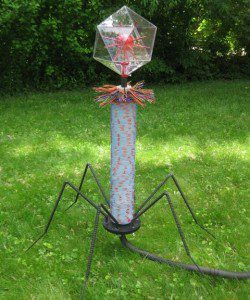

By Gertrud U. Rey
Quorum sensing is a form of cell to cell communication in bacteria in which individual cells coordinate their behavior based on population density. In human terms, the word “quorum” means “the minimum number of people required to conduct business.”
During quorum sensing, bacteria produce and release chemical signaling molecules called autoinducers. When the number of bacteria is low, any autoinducer produced may just diffuse away and nothing much happens. However, as bacteria increase in number, so does the density of autoinducers. The increased number of autoinducers is then more likely to be detected by other bacteria, enabling them to coordinate their behaviors as a group. Such behaviors include motility, expression of virulence factors, biofilm formation, bioluminescence, nitrogen fixation, and sporulation.
Because this is a blog about viruses, you may ask yourself why I’m telling you a story about bacteria. A week ago, Justin Silpe and Bonnie Bassler of Princeton University published a really cool paper, in which they showed that a bacteriophage (“phage” for short) named VP882 can monitor the density of autoinducers. Since phages are viruses that infect bacteria, and are hence obligate intracellular parasites, their existence depends on the presence of viable hosts. Having the ability to monitor the number of potential hosts would allow a phage to select the best time for launching an infection, while simultaneously ensuring an excess of new hosts for its offspring.
VP882 is a “temperate” phage that infects Vibrio cholerae, the bacterium that causes cholera. Temperate phages can switch between a lysogenic and lytic life cycle, i.e., one where they integrate their genome and become latent, and one where they actively replicate and kill the cell. If growth conditions are poor at the time of infection, the phage may enter the lysogenic pathway and exist latently as a stable plasmid or integrated prophage. Once bacterial growth conditions become more favorable, the phage can switch to a lytic program, inducing the production of offspring and lysis of the host cell.
For the well-studied phage lambda, the lysis-lysogeny decision depends on the activity or inactivity of a protein known as “Cl.” Cl is a transcriptional repressor that inhibits the expression of a phage lytic gene named “Q,” thus committing the phage to lysogeny. Silpe and Bassler found that VP882 encodes a receptor that binds an autoinducer produced by Vibrio cholerae, and this binding induces a phage gene called qtip (quorum-triggered inactivator of cl protein). Once activated, qtip sequesters and inactivates Cl protein. Having lost its repressor, Q is then free to activate the phage lytic pathway.
Silpe and Bassler also found that they could reprogram VP882 to target and selectively induce lysis in various bacterial species other than Vibrio cholerae by using different promoters for Q. This finding provides immense insight into the possibility of using phages as an alternative to antibiotics, because it allows for better specificity and timing of bacterial killing.
There are many potential advantages to phage therapy. Presently, the most important advantage is that phages are equally effective against antibiotic-sensitive and antibiotic-resistant bacteria. The specificity of bacterial killing by phage would also lead to reduced impact on commensal bacteria, which are typically obliterated by conventional antibiotics. In addition, phages are capable of disrupting bacterial biofilms, and their use would lead to reduced incidence of opportunistic infections and reduced toxic effects.
Nevertheless, the authors are careful to note that these studies were done in vitro and do not necessarily predict success in clinical applications. For example, as described in a previous post, the host innate immune system may play a critical role in the efficacy of phage therapy.
[The material in this blog post is also covered in this video.]

Pingback: These Bacteria are Bugged – Virology
Pingback: These Bacteria are Bugged -
Pingback: TWiM 192: A Qtip for phages | This Week in Microbiology